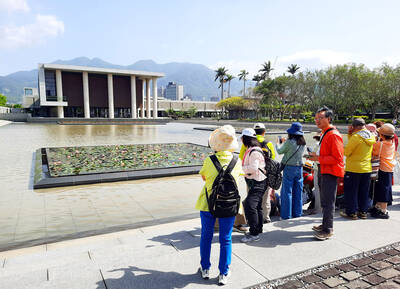Residents of Taipei who are stuck in the city during the Lunar New Year often resort to eating, drinking and playing mahjong for wholesome family entertainment. A more lively alternative will be staged next weekend: free outdoor performances from Spain and Taiwan’s Amis tribe (阿美族) at the Chiang Kai-shek Memorial Hall Plaza, which open the 2010 Taiwan International Festival (2010台灣國際藝術節).
The festival, whose theme is Diversity and Sustainability, runs through March 28 and features Taiwanese and international performances of dance, music and theater from nine countries including Germany, France, Denmark and Colombia.
Spain’s Sol Pico Dance Company draws attention to the issue of dwindling water supplies in Sirena a la Plancha, an abundantly humorous and sensual performance that tells the story of a woman who changes into a mermaid to save the world from drying up.
Sirena a la Plancha is approximately one hour long and begins at 8pm on Feb. 19.
For Ilisin — Amis Harvest Festival Dances, the Formosa Aboriginal Song & Dance Troupe (原舞者) brings the harvest dances of the Amis communities of Hualien to the capital.
More than 200 Aboriginal performers will participate in the year-end festival, held to worship and offer gratitude to ancestors and deities as well as pray for good harvests and fortune in the
coming year.
The Ilisin festival, which usually lasts several days, has been condensed into a two-hour long event that begins on Feb. 20 at 6pm.
A daring attempt at blending tribal sounds with a Western orchestra and contemporary music, On the Road (很久沒有敬我了你) was born of a collaboration between Aboriginal musicians from Taiwan Colors Music (角頭音樂) and the National Symphony Orchestra (NSO, 國家交響樂團) under conductor Chien Wen-pin (簡文彬). It hits the National Concert Hall stage later this month
British composer George Fenton continues the green theme with The Blue Planet Live, a concert that sees the NSO and Taipei Philharmonic Chorus (台北愛樂合唱團) performing the multi-award winning score Fenton wrote for the television documentary series The Blue Planet, produced by the BBC and Discovery Channel.
Taiwan International Festival’s bilingual Web site can be found at tif.ntch.edu.tw.

When the South Vietnamese capital of Saigon fell to the North Vietnamese forces 50 years ago this week, it prompted a mass exodus of some 2 million people — hundreds of thousands fleeing perilously on small boats across open water to escape the communist regime. Many ultimately settled in Southern California’s Orange County in an area now known as “Little Saigon,” not far from Marine Corps Base Camp Pendleton, where the first refugees were airlifted upon reaching the US. The diaspora now also has significant populations in Virginia, Texas and Washington state, as well as in countries including France and Australia.

On April 17, Chinese Nationalist Party (KMT) Chairman Eric Chu (朱立倫) launched a bold campaign to revive and revitalize the KMT base by calling for an impromptu rally at the Taipei prosecutor’s offices to protest recent arrests of KMT recall campaigners over allegations of forgery and fraud involving signatures of dead voters. The protest had no time to apply for permits and was illegal, but that played into the sense of opposition grievance at alleged weaponization of the judiciary by the Democratic Progressive Party (DPP) to “annihilate” the opposition parties. Blamed for faltering recall campaigns and faced with a KMT chair

Article 2 of the Additional Articles of the Constitution of the Republic of China (中華民國憲法增修條文) stipulates that upon a vote of no confidence in the premier, the president can dissolve the legislature within 10 days. If the legislature is dissolved, a new legislative election must be held within 60 days, and the legislators’ terms will then be reckoned from that election. Two weeks ago Taipei Mayor Chiang Wan-an (蔣萬安) of the Chinese Nationalist Party (KMT) proposed that the legislature hold a vote of no confidence in the premier and dare the president to dissolve the legislature. The legislature is currently controlled

Dull functional structures dominate Taiwan’s cityscapes. But that’s slowly changing, thanks to talented architects and patrons with deep pockets. Since the start of the 21st century, the country has gained several alluring landmark buildings, including the two described below. NUNG CHAN MONASTERY Dharma Drum Mountain (法鼓山, DDM) is one of Taiwan’s most prominent religious organizations. Under the leadership of Buddhist Master Sheng Yen (聖嚴), who died in 2009, it developed into an international Buddhist foundation active in the spiritual, cultural and educational spheres. Since 2005, DDM’s principal base has been its sprawling hillside complex in New Taipei City’s Jinshan District (金山). But